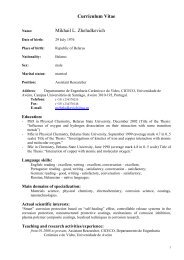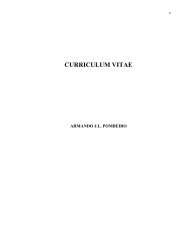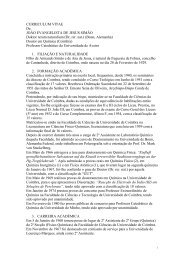XII Iberian Meeting of Electrochemistry XVI Meeting of the ...
XII Iberian Meeting of Electrochemistry XVI Meeting of the ...
XII Iberian Meeting of Electrochemistry XVI Meeting of the ...
Create successful ePaper yourself
Turn your PDF publications into a flip-book with our unique Google optimized e-Paper software.
<strong>XII</strong> <strong>Iberian</strong> <strong>Meeting</strong> <strong>of</strong> <strong>Electrochemistry</strong> & <strong>XVI</strong> <strong>Meeting</strong> <strong>of</strong> <strong>the</strong> Portuguese Electrochemical Society PD 04<br />
Electrochemical characterization <strong>of</strong> polypyrrole-based<br />
conducting fabrics in different pH media<br />
Javier Molina, Javier Fernández, Ana Isabel del Río, José Bonastre,<br />
Francisco Cases<br />
Departamento de Ingeniería Textil y Papelera, EPS de Alcoy, Universidad Politécnica de Valencia,<br />
Plaza Ferrándiz y Carbonell s/n, 03801 Alcoy, Spain<br />
jamopue@doctor.upv.es<br />
Conducting fabrics <strong>of</strong> polyester covered with polypyrrole have been electrochemically<br />
characterized at different pHs (1, 7 and 13). The stability <strong>of</strong> <strong>the</strong> conducting fabrics in<br />
different pHs is fundamental in views <strong>of</strong> its application in electronic textiles or<br />
electrocatalysis. In <strong>the</strong> study, two counter ions have been employed: AQSA (organic)<br />
and PW 12 O 3- 40 (inorganic). The electrochemical techniques that have been employed for<br />
<strong>the</strong> electrochemical characterization have been cyclic voltammetry (CV) and scanning<br />
electrochemical microscopy (SECM). It has been demonstrated <strong>the</strong> influence <strong>of</strong> <strong>the</strong> scan<br />
rate in <strong>the</strong> form <strong>of</strong> <strong>the</strong> voltammograms obtained. High scan rates (50 mV·s -1 ) did not<br />
allow <strong>the</strong> observation <strong>of</strong> <strong>the</strong> redox processes and a resistive response was obtained. On<br />
<strong>the</strong> o<strong>the</strong>r hand, low scan rates (1mV·s -1 ) allowed <strong>the</strong> apparition <strong>of</strong> <strong>the</strong> redox peaks. The<br />
charge transfer is produced across <strong>the</strong> polymer chains since polyester is an insulating<br />
material. Lower pHs produced a higher and more characteristic electrochemical<br />
response due to <strong>the</strong> influence <strong>of</strong> protonation on <strong>the</strong> polypyrrole activity [1].<br />
SECM allows <strong>the</strong> possibility <strong>of</strong> studying zonal electroactivity at its open circuit<br />
potential. Approach curves were obtained by SECM for <strong>the</strong> samples <strong>of</strong> PPy/AQSA and<br />
3-<br />
PPy/PW 12 O 40 treated at different pHs. Positive feedback was obtained for all <strong>the</strong><br />
conducting fabrics samples, so <strong>the</strong> fabrics were electroactive. The degree <strong>of</strong> positive<br />
feedback varied on <strong>the</strong> nature and <strong>the</strong> treatment <strong>of</strong> <strong>the</strong> polypyrrole layer. An increase in<br />
<strong>the</strong> pH <strong>of</strong> <strong>the</strong> solution caused <strong>the</strong> loss <strong>of</strong> part <strong>of</strong> <strong>the</strong> counter ions as XPS measurements<br />
have revealed and <strong>the</strong> layer electroactivity was affected. The organic counter ion was<br />
more stable than <strong>the</strong> inorganic one at pH 13. This is due to a reaction <strong>of</strong> decomposition<br />
that suffers <strong>the</strong> PW 12 O 3- 40 at pH>8.3 [2]. The PW 12 O 3- 40 decomposed into PO 3- 4 and<br />
WO 2- 4 [2].<br />
Acknowledgments: Authors thank to <strong>the</strong> Spanish Ministerio de Ciencia y Tecnología and European<br />
Union Funds (F EDER) (contract CTM2007-66570-C02-02) and Universidad Politécnica de<br />
Valencia (Programa de apoyo a la investigación y desarrollo de la UPV (PAID-05-08)) for <strong>the</strong><br />
financial support. J. Molina and A.I. del Río are grateful <br />
(Generalitat Valenciana) and <strong>the</strong> Spanish Ministerio de Ciencia y Tecnología respectively for <strong>the</strong><br />
FPI fellowship.<br />
References<br />
[1] Krzyszt<strong>of</strong> M. Electroanalysis, 2006, 18, 1537.<br />
[2] Zu Z.; Tain R.; Rhodes C. Canadian Journal <strong>of</strong> Chemistry, 2003, 81, 1044.<br />
September, 811, 2010. ISEL - Lisbon 86








